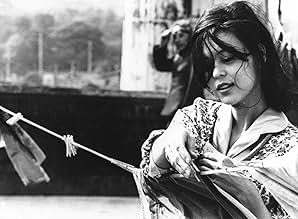CALIFICACIÓN DE IMDb
7.9/10
11 k
TU CALIFICACIÓN
Un hombre de negocios con el rostro desfigurado obtiene una máscara realista de su médico, pero la máscara comienza a alterar su personalidad.Un hombre de negocios con el rostro desfigurado obtiene una máscara realista de su médico, pero la máscara comienza a alterar su personalidad.Un hombre de negocios con el rostro desfigurado obtiene una máscara realista de su médico, pero la máscara comienza a alterar su personalidad.
- Premios
- 2 premios ganados en total
Robert Dunham
- Foreign man in Bar
- (sin créditos)
Argumento
¿Sabías que…?
- TriviaDirector Hiroshi Teshigahara said that he intended the film to explore both personal and cultural identities. While the examination of personal identity is quite overt, Teshigahara also explored how Japan's cultural identity had been impacted by World War II and its aftermath.
- Citas
Psychiatrist: You're not the only lonely man. Being free always involves being lonely. Just there is a mask you can peel off and another you can not.
- ConexionesReferenced in Desfile fúnebre de rosas (1969)
Opinión destacada
Teshigahara has never shied away from examining the more unsettling dimensions of human experience. With the trilogy of full-length collaborations with Kobo Abe, Teshigahara encapsulated the Kafkaesque hellishness of quotidian life, the yawning, gaping chasm of emptiness that lies beneath the veneer of stability.
The ubiquitous influence of the French absurdists/existentialists, Kafka and Dostoevsky looms large here- one is reminded most often of Sartre's "No Exit", R.D. Laing's "Knots" and Dostoevsky's "Crime And Punishment". Sartre, Laing and Abe all underline how little autonomy we really have over constituting our own identities- often, we may find that we exist only as beings-for-others, entirely 'encrusted' within personas not of our own making, but assigned to us. For Okuyama and the unnamed scarred woman, they are imprisoned in their vulgar corporeality. Met with revulsion everywhere, they come to accept ugliness as an indelible mark of their being. Trapped within the oppressive confines of flesh, they cannot evade the pity and repugnance that their countenances arouse. It is little wonder that Okuyama becomes self-lacerating and embittered.
Throughout the film, the viewer confronts how precarious identity truly is- the assumption that selves are continuous and linear from day-to-day rests entirely on the visage. The doctor's paroxysm of inspiration in the beer hall affords a glimpse into the anarchic potential of his terrible invention, one that would rend civilization asunder. Indeed, the final epiphany is particularly unnerving- "some masks come off, some don't". We all erect facades, smokescreens of self that we maintain with great effort.
Beneath the epidermis, as Okuyama discovers, is vacuity and nihility. This is likely the explanation for Okuyama's gratuitous, Raskolnikov-esquire acts of crime at the conclusion of the film- faced with the frontierless void of freedom, he desires to be apprehended and branded by society. Integration into society, after all, requires a socially-assigned, unified role, constituted by drivers licenses, serial numbers and criminal records. Without such things, Okuyama is a non-entity.
Aesthetically, the film exhibits all the rigour and poetry of Teshigahara's other work. Cocteau, Ernst and Duchamp, in particular, are notable wellsprings for the film's visual grammar. Literate, expressionistic and profoundly disorienting, this might be my favorite Teshigahara work.
The ubiquitous influence of the French absurdists/existentialists, Kafka and Dostoevsky looms large here- one is reminded most often of Sartre's "No Exit", R.D. Laing's "Knots" and Dostoevsky's "Crime And Punishment". Sartre, Laing and Abe all underline how little autonomy we really have over constituting our own identities- often, we may find that we exist only as beings-for-others, entirely 'encrusted' within personas not of our own making, but assigned to us. For Okuyama and the unnamed scarred woman, they are imprisoned in their vulgar corporeality. Met with revulsion everywhere, they come to accept ugliness as an indelible mark of their being. Trapped within the oppressive confines of flesh, they cannot evade the pity and repugnance that their countenances arouse. It is little wonder that Okuyama becomes self-lacerating and embittered.
Throughout the film, the viewer confronts how precarious identity truly is- the assumption that selves are continuous and linear from day-to-day rests entirely on the visage. The doctor's paroxysm of inspiration in the beer hall affords a glimpse into the anarchic potential of his terrible invention, one that would rend civilization asunder. Indeed, the final epiphany is particularly unnerving- "some masks come off, some don't". We all erect facades, smokescreens of self that we maintain with great effort.
Beneath the epidermis, as Okuyama discovers, is vacuity and nihility. This is likely the explanation for Okuyama's gratuitous, Raskolnikov-esquire acts of crime at the conclusion of the film- faced with the frontierless void of freedom, he desires to be apprehended and branded by society. Integration into society, after all, requires a socially-assigned, unified role, constituted by drivers licenses, serial numbers and criminal records. Without such things, Okuyama is a non-entity.
Aesthetically, the film exhibits all the rigour and poetry of Teshigahara's other work. Cocteau, Ernst and Duchamp, in particular, are notable wellsprings for the film's visual grammar. Literate, expressionistic and profoundly disorienting, this might be my favorite Teshigahara work.
- nin-chan
- 11 ene 2008
- Enlace permanente
Selecciones populares
Inicia sesión para calificar y agrega a la lista de videos para obtener recomendaciones personalizadas
- How long is The Face of Another?Con tecnología de Alexa
Detalles
Taquilla
- Total a nivel mundial
- USD 35,185
- Tiempo de ejecución2 horas 2 minutos
- Color
- Mezcla de sonido
- Relación de aspecto
- 1.33 : 1
Contribuir a esta página
Sugiere una edición o agrega el contenido que falta

Principales brechas de datos
What is the French language plot outline for Tanin no kao (1966)?
Responda

































